In the dynamic landscape of industrial quality control and materials analysis, the choice between portable and stationary testing tools presents a significant operational decision. This dichotomy shapes workflows, influences productivity, and ultimately impacts the bottom line across manufacturing sectors. Unlike conventional thinking that simplistically pits mobility against precision, today’s technological advances have blurred these traditional boundaries, creating a nuanced decision matrix for quality engineers and operations managers.
Transforming Accessibility in Remote Environments
Portable testing tools have revolutionized inspection processes in hard-to-reach locations. Consider oil rigs stationed miles offshore, where bringing large equipment samples back to land-based laboratories creates logistical nightmares and costly production delays. Compact handheld spectrometers and ultrasonic thickness gauges now bring laboratory-grade analysis directly to these remote installations, enabling real-time decision-making that was previously impossible.
The ability to conduct comprehensive testing in isolated conditions extends beyond maritime operations. Mining operations in remote mountainous regions benefit from portable X-ray fluorescence analyzers that provide immediate elemental composition data, eliminating the need to transport geological samples across difficult terrain. This immediate feedback loop transforms exploration efficiency and resource management in ways that stationary equipment simply cannot match.
Integration with ball grinder Systems for Enhanced Performance
The relationship between portable testing tools and ball grinder systems represents an emerging symbiosis in manufacturing quality control. Modern portable testing devices now integrate seamlessly with grinding optimization software, enabling operators to make immediate adjustments to grinding parameters based on real-time material property feedback. This integration transforms what was once a disconnected process into a continuous improvement cycle, particularly valuable in cement and mineral processing industries.
The convergence of testing mobility and grinding precision creates unprecedented opportunities for energy efficiency. By continuously monitoring material properties during the grinding process, operators can fine-tune ball grinder settings to achieve optimal particle size distribution with minimal power consumption. This synergistic relationship between portable testing technology and industrial grinding systems illustrates how mobility does not necessarily sacrifice sophistication or capability.
Manufacturing Floor Precision Without Movement Limitations
While portable solutions offer compelling mobility benefits, stationary testing systems maintain distinct advantages in controlled environments. High-precision laser measurement systems anchored to stable foundations achieve micron-level accuracy impossible with handheld alternatives. This unwavering precision makes stationary equipment irreplaceable for industries like aerospace manufacturing, where component tolerances leave virtually no margin for error.
Stationary testing equipment also enables comprehensive automation integration that portable alternatives struggle to match. Robotic handling systems seamlessly feed components through elaborate testing sequences without human intervention, creating manufacturing cells that operate continuously with minimal supervision. This automation capability extends testing throughput far beyond what portable tools can achieve, particularly for high-volume production environments where testing frequency scales with output.
Environmental Resilience and Accuracy Trade-offs
The operating environment dramatically influences testing equipment performance. Portable tools designed for field deployment incorporate ruggedized components that withstand temperature extremes, dust exposure, and occasional impacts. These durability features inevitably add weight and sometimes compromise ultimate measurement precision—a necessary trade-off for environmental versatility.
Stationary systems benefit from controlled laboratory conditions that eliminate environmental variables, enabling more sensitive detection methodologies. Mass spectrometers and electron microscopes require stable temperatures, minimal vibration, and controlled humidity—conditions impossible to replicate in field settings. This environmental stability allows stationary equipment to detect molecular structures and material compositions at resolutions portable equipment cannot approach, making them essential for advanced research applications.
Financial Implications Beyond Acquisition Costs
The financial comparison between portable and stationary testing tools extends far beyond initial purchase prices. Portable systems generally represent lower upfront investments but often incur higher per-test costs through consumable materials and calibration requirements. Stationary systems typically demand significant initial capital but distribute these costs across higher testing volumes and longer operational lifespans.
Operational efficiency calculations must incorporate facility requirements into this financial equation. Stationary systems require dedicated floor space, specialized utility connections, and sometimes custom environmental controls—space and infrastructure investments that portable systems avoid entirely. For organizations with limited facility resources or those facing uncertain future space allocation, portable testing solutions offer financial flexibility that fixed installations cannot match.
Technological Convergence Reshaping Traditional Categories
Emerging technologies are increasingly blurring the once-clear boundaries between portable and stationary testing equipment. Semi-portable systems mounted on wheeled carts with quick-connect power and data interfaces represent a hybrid category that combines mobility with sophisticated testing capabilities. These intermediate solutions can be repositioned throughout a facility as testing priorities shift while maintaining calibration stability superior to fully portable alternatives.
Augmented reality interfaces now enable remote experts to guide on-site technicians through complex testing procedures using portable equipment, effectively bringing specialized expertise to field locations without physical travel. This technological approach combines the advantages of portable hardware with the knowledge base traditionally associated with sophisticated laboratory environments, creating testing capabilities that transcend traditional categorization.

Influencing Implementation Success
The human element remains central to testing equipment effectiveness regardless of mobility classification. Portable testing tools typically feature simplified interfaces designed for operation by personnel with varied technical backgrounds, making them accessible across wider organizational roles. This accessibility expands testing frequency and integration into daily operations but may limit advanced analysis capabilities.
Stationary systems often require specialized operator training and technical backgrounds, creating staffing dependencies that organizations must address through hiring or development programs. This expertise requirement represents an operational consideration beyond the equipment itself—a factor particularly relevant for organizations in regions with limited access to specialized technical talent or training resources.
Final Thoughts: Complementary Approaches Rather Than Competitors
The most successful testing strategies increasingly recognize portable and stationary testing equipment as complementary rather than competing approaches. Progressive organizations deploy portable tools for screening and routine verification while maintaining stationary systems for reference standards and dispute resolution. This layered approach leverages the speed and accessibility of portable testing with the definitive precision of stationary equipment.
The optimal balance between portable and stationary testing capabilities ultimately depends on industry-specific requirements, geographic distribution of operations, and production volumes rather than universal superiority of either approach. Organizations that thoughtfully evaluate these factors develop testing ecosystems that combine mobility and precision in proportions that align with their specific operational realities. This nuanced perspective replaces the oversimplified question of which approach is “better” with the more productive consideration of how these distinct capabilities can be strategically deployed to create comprehensive quality assurance systems optimized for specific organizational needs.
As testing technology continues its rapid evolution, the most valuable perspective may not be choosing between portable and stationary options, but rather understanding how to integrate these complementary capabilities into a cohesive testing strategy that delivers both operational flexibility and analytical confidence.







